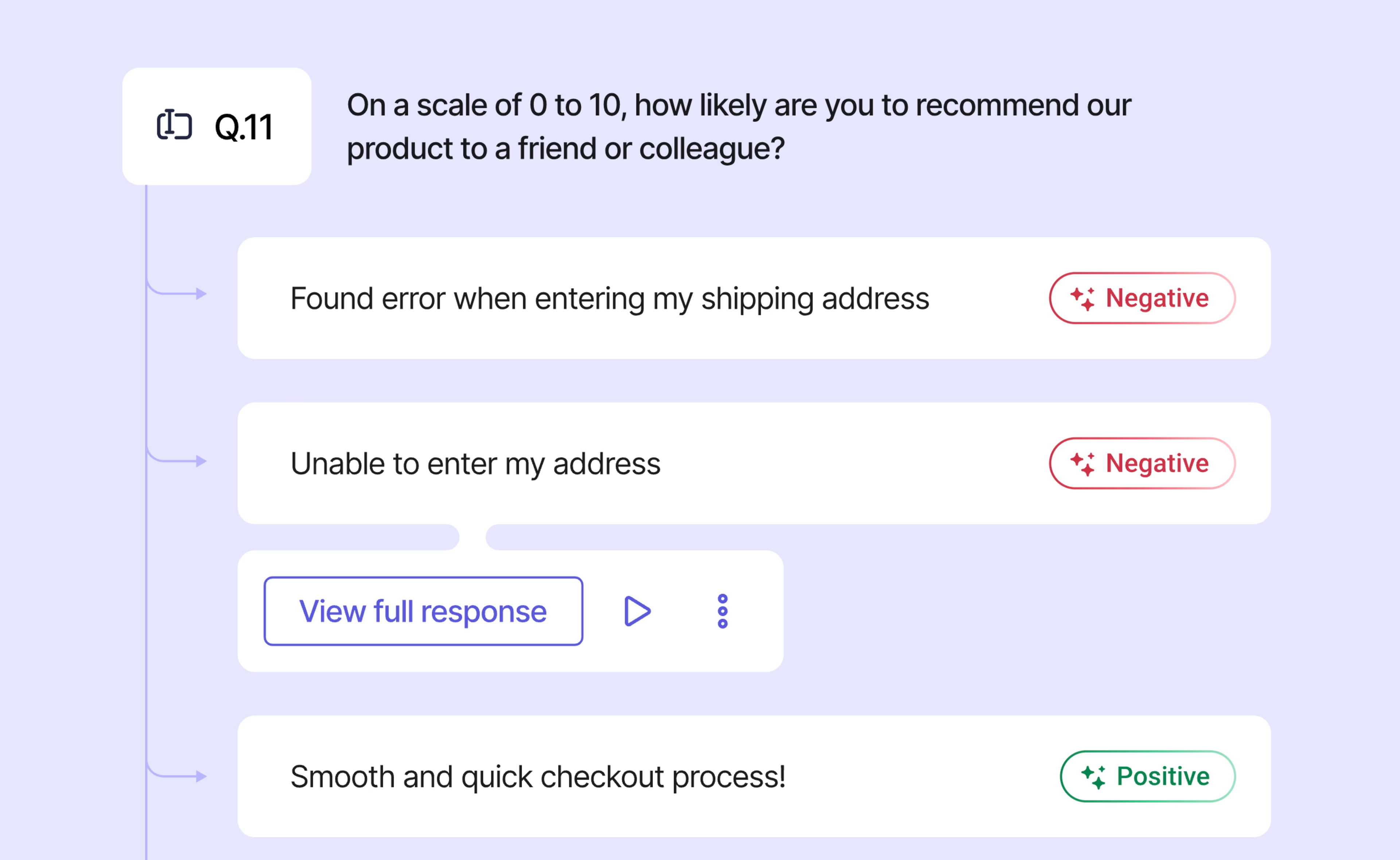Product management is a varied, dynamic field that significantly impacts organizations and their stakeholders. Product managers combine user-focus, business savvy, and tech expertise to create strong product outcomes.
But the flexible, wide-ranging scope that makes product management exciting can also create confusion. Where do product management roles end and other roles begin? And what’s the actual day-to-day work of product management?
This article answers key questions on what product management is—and how product management teams can excel.
TL;DR
Product management is the strategic oversight of a product's entire lifecycle, aligning user needs with business goals to create viable and successful products
Product manager tasks often include
Staying in touch with user needs
Defining product vision and roadmap
Aligning and empowering the product team
Creating a shared product understanding with stakeholders
There are seven basic product management processes which are:
Finding the problem you want to solve
Questioning the problem
Testing possible solutions
Defining a solution
Getting cross-functional buy-in
Building a Minimum Viable Product
Guiding execution
These product management skills will help you thrive:
Deep research
Knowing where to prioritize
Empathy for users
Storytelling
Inspirational leadership
Contentsquare helps product management teams with tools like Zone-Based Heatmaps, Session Replays, Customer Journey Analysis, Exit Intent Surveys and Feedback Buttons. These tools let product teams understand users, develop and prioritize, get buy-in, and engage in continuous discovery.
What is product management?
Product management is the process of strategically directing every stage of the product lifecycle—from research and development to testing and positioning—to build technically feasible products that fulfill both user needs and business objectives.
In short: product managers analyze business, tech, and user goals, then define product solutions and guide a product team to deliver them.
What do product managers do?
Since the emergence in the 1930s of the 'brand man'—someone responsible for a product from start to finish—product management roles have continued to evolve.
And the roles differ across companies: smaller companies may have a single product manager who does a bit of everything, while in larger companies, there are often multiple PMs, some senior and strategic, and some specialized in tech, marketing, or operational ownership.
As a result, what product managers focus on varies.
However, a typical product team structure might include:
Director of product management
Product manager
Chief product officer
Product designer
Product owner
Product engineers
Growth product manager
Test engineers
Key focus points in product management usually include:
Staying in touch with user needs: Product managers conduct a burst of initial product research. Then, throughout the product lifecycle, PMs stay in constant contact with users and their needs to adapt product priorities as needed.
Defining product vision and roadmap: PMs define the product vision, create roadmaps with key milestones and KPIs, while remaining flexible to pivots
Aligning and empowering the product team: PMs align diverse product team roles around shared goals, delegate tasks, and ensure resources are available
Creating a shared product understanding with stakeholders: Product managers ensure cross-functional alignment by facilitating relevant information between tech and business stakeholders. As a result, PMs are responsible for getting buy-in for their ideas.
7 basic product management processes
There’s no one way to do product management. That’s why this section talks about 'product management processes'—in the plural, not singular.
Typical processes for product managers usually involve:
1. Finding the problem you want to solve
The first step is figuring out which user pain points your product could address.
Ideas can come from user feedback, issues with current tools you offer, gaps in the wider market, or business needs and goals.
Many PMs also discover critical problems by listening to different stakeholders, like business departments and other product teams. Product managers don’t have to discover problems—and generate solutions—alone:
As soon as you recognize that product managers are the connective tissue between the people you work with and between business and customer goals, the more powerful and prioritized every action you take will be. It’s about aligning people around problems and solutions, not coming up with them all on your own.
Ariana Dugan, VP of Product at Interplay Learning
2. Questioning the problem
At the next stage, product managers start thinking about business goals. They run user interviews and competitive analysis to understand how solving the problem identified in the first step could help their product meet user goals—like creating customer delight—and organizational goals—like profitability.
Product managers aim to answer questions like:
👉 How big is the opportunity for this problem?
👉 Will people pay for solutions to this problem?
👉 Do solutions already exist? Do they work?
3. Testing possible solutions
Once product managers have identified the right problem to address, they work with their team to generate ideas for product solutions.
Before deciding which solution to focus on, they’ll do more user research, gather feedback, and maybe present wireframes or models to test an ideas' possible value and feasibility.
4. Defining a solution
When a viable solution has been identified, it’s time to define a clear product vision and ensure your product vision ties into the entire product experience.
The best products are the ones that are built in a way that means you can’t guess which team they came from.
When each product team is trying to move forward in its respective product area, a consequence can be local sub-optimizations at the expense of the bigger picture. At the expense of that cohesive experience.
As you define your solution, ask yourself how it benefits the end user, and ultimately, ties into the rest of the products your company offers.
5. Getting cross-functional buy-in
A crucial part of product management is convincing stakeholders from different departments to support—and allocate resources—to your new product ideas.
Product managers usually present their vision and roadmap to executives and other decision-makers for buy-in before going ahead with the product plan.
6. Building a Minimum Viable Product
The next step is creating a minimum viable product (MVP). This involves creating a simple version of the product with basic features and releasing it onto the market to test its functionality.
MVP isn’t about building a minimum product with poor quality. Aim to build the minimal unit of value (in an emotionally connected way) to give an experience that's mutually beneficial for the people who use the product and the people who make the product.
7. Guiding execution
Finally, the product manager leads the development and engineering teams through executing the product vision.
Most product teams use agile methodology, which means this won’t be a single fixed process, but rather a series of different product sprints and iterations with testing in between.
Once a final product has been delivered, the product management role shifts to positioning the product in the market, gathering user feedback, and prioritizing tasks in the product backlog to ensure bugs are fixed and new features are added.
5 skills to thrive in product management
With so many complex roles and responsibilities, PMs experience many product management challenges.
To meet those challenges and excel as a product manager, you should develop five key skills:
1. Deep research
To excel as a product manager, you need to evaluate and assimilate large amounts of information.
Start by developing a stable knowledge base: stay up to date with tech trends, figure out what your future customer needs, get to grips with the market, and learn about your typical user models.
Then, go deeper. Get curious about your users and product space and dedicate time and resources to understanding what goals users have and how your product helps them achieve those goals.
2. Knowing where to prioritize
Product managers need to make difficult decisions. With limited time and resources, and requests pouring in from different stakeholders, it’s impossible to get everything in the product backlog done.
You need to weigh up the options and decide what’s most important for your team to focus on. Make data-driven decisions to streamline your backlog management and stay connected to core user and business metrics.
Pro tip: even when you’ve weeded out low-priority tasks, as a product manager, you’ll be pulled between several different types of work in a single day.
Constantly switching back and forth can disrupt focus and waste time.
Schedule similar tasks—like research activities or report writing—together in blocks or chunks to avoid context-switching and maximize your cognitive resources.
3. Empathy for users
User needs are everything to product managers.
Ensure you’re in constant conversation with your customers—but the quality of the conversation is more important than quantity. Endless user interviews won’t make much of a difference if you don’t care deeply about your users.
Cultivate a deep interest in what your users are thinking and feeling. Start by looking at user experience, then go beneath the surface to discover their underlying frustrations, wants, and needs.
As you develop your product, prioritize intuitive design. Aim for a product that's immediately usable and useful to avoid user frustration. Build empathy into your product by consistently considering the user's perspective throughout the development process.
4. Storytelling
An essential function of product management is crafting compelling, relevant stories about your users and products.
Weave your key user insights into a persuasive narrative. Then, use it to convince stakeholders and get your team invested in the product roadmap.
Pro tip: maintain a balance between individual user stories and the big picture.
It’s easy to get caught up in a single compelling user experience story and forget to zoom out and look at trends. It’s just as easy to focus on overview metrics and miss the emotional pull of user stories that can show you where the real value is.
Contentsquare’s mix of qualitative and quantitative tools—like Zone-Based Heatmaps and Exit Intent Surveys—give you balanced data to keep you on the right track.

5. Inspirational leadership
Inspire and motivate your team by helping them understand how the products they’re working on contribute to organizational goals. Involve your team in key product decisions and spend time understanding how your product team works best.
The best product managers trust their team. They empower every team member to take ownership of their tasks—and ensure they have all the resources and support they need.
5 ways Contentsquare helps product management teams
Contentsquare offers rich, continuous product experience insights that are gold dust for product management teams.
Contentsquare can help you:
1. Get an overview of the user experience
Contentsquare Heatmaps, Session Replays, and Customer Journey Analysis help you zoom out and understand how your user base uses and responds to your tools.
2. Use VoC data to determine underlying user needs
Exit Intent Surveys and Feedback Buttons help you go deeper through VoC insights. Customers can tell you their frustrations, wins, and underlying needs—all in their own words.
3. Feel confident prioritizing your backlog
Heatmaps, Session Replays, Journey Analysis, and Feedback tools help you identify where things are going wrong with your product. Aside from helping you fix immediate issues, these tools show you what’s most important to users, giving you confidence in your bigger product decisions.
4. Create compelling stories for buy-in from executives
Contentsquare Heatmaps, Journey Analysis, and Session Replays give you powerful quantitative data you can use to show executives the scale and scope of user problems. And data from Voice of Customer tools will help in convincing them to get behind your product vision on an emotional level.
5. Engage in continuous discovery
Contentsquare’s tools give you a steady stream of user data broken up into small, regular chunks. Without needing to do time-consuming user interviews, you can stay constantly connected to your users.
Finally: exceptional product management is an art form.
The best product managers are never done learning: they constantly strive to create better products through better user understanding. By developing key research, leadership, and storytelling skills—and using tools like Contentsquare for user insights—you’ll be well on your way to product management success.

![[Visual] Contentsquare's Content Team](http://images.ctfassets.net/gwbpo1m641r7/3IVEUbRzFIoC9mf5EJ2qHY/f25ccd2131dfd63f5c63b5b92cc4ba20/Copy_of_Copy_of_BLOG-icp-8117438.jpeg?w=1920&q=100&fit=fill&fm=avif)